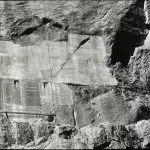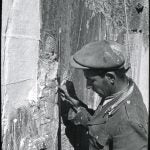From the Archives — January 2017
BY SEBASTIÁN ENCINA, Museum Collections Manager
Upon entering the Kelsey Museum, visitors are greeted by an imposing and daunting figure. King Darius the Great of the Persian Empire stands before them with a warning for those who cast gaze upon him. The reproduction on display is made from a negative impression taken at the site of the original monumental relief at Bisitun (Behistun), Iran. There, about 100 meters up on the side of a mountain, we see Darius and his soldiers as they conquered would-be usurpers. Darius, in his grandiosity, displays his power in a manner befitting his reign.
The cast on display at the Kelsey was made from a latex squeeze formed by U-M professor George Cameron in 1948 on his visit to Iran (and other locations). Some photographs of the squeeze-making are on display with the cast, but recently a collection of more Cameron photographs have found their way to the Kelsey via History of Art. These remained uncatalogued for years, until they were re-discovered and entered into the Kelsey photographs database.
The images show Cameron’s visit to Iran, and the process of squeeze-making. We also get a glimpse of the local village from high atop the mountain. We see the people working with him, including a young unnamed boy that may be related somehow to Cameron. But what is most impressive is the sheer placement of the relief, high on this mountain, dangerous to get to. At this height, it would be a daunting task to place anything, but Darius had his own image, his soldiers, and his captives here as well (with one underfoot). Above them is the god Ahura Mazda who bestowed upon Darius this victory.
Surrounding the entire scene is the text of Darius’ proclamation and details of his accomplishments. He speaks of the evils, the lies, and how some would take what is rightfully his. As seen in the photographs (and more easily determined from the drawing), the text reaches high above and below the figures. It stretches far to the right and all the way to the left. Darius had plenty to say, but the real reason for so much text is that Darius, great as he was, was aware that this location was along a major trade route. Though he could have written the inscription in Persian only, he knew people along the road spoke various languages. Thus, the text is found in Persian, Elamite, and Babylonian. Thanks to this, researchers were able to take what they knew of Persian and use the rest to translate and understand the cuneiform script employed.
The use of multiple languages is not new. We have seen that elsewhere, such as Romans speaking Greek about the Mediterranean, or the Rosetta Stone of Egypt, and how it allowed us to understand Egyptian hieroglyphics. It is an awareness that multiculturalism exists, and by taking note of this, the message can be disseminated more broadly.
From the Archives — January 2017 Read More »




































